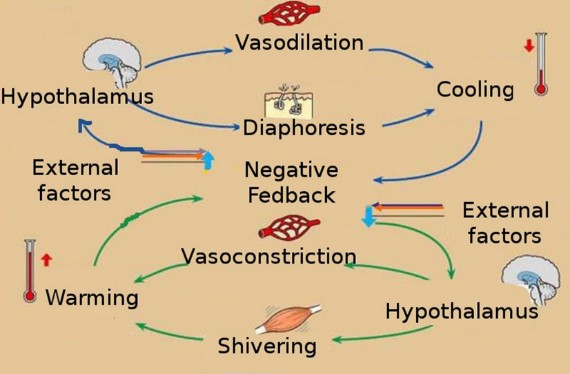Learn
Homeostasis
Homeostasis is a process essential for survival. It can be defined as the maintenance of an internal “set point” in response to a fluctuating external environment. Another way to define it is the maintaining of equilibrium by regulating the internal environment. Without homeostasis, pathology, disease, or even death can result.
Examples of “set points” that must be maintained by homeostatic mechanisms are core body temperature of 98.6°F (average), blood glucose level of 100mg/100ml of blood (average), and blood pressure of 120/70 mm/Hg (average).
Homeostasis is a process essential for survival. It can be defined as the maintenance of an internal _________ in response to a fluctuating external environment.
Answer: setpoint
Why is homeostasis important to survival?
Without it, disease and even death can occur.
Negative Feedback Systems and Components
Homeostasis is maintained through feedback control systems. The most common of these is the negative feedback mechanism.
Negative feedback mechanisms, or loops, are inhibitory in nature, meaning they oppose the change from the “set point” causing the opposite effect. Body temperature control is a negative feedback system that occurs in the body. If the body temperature rises or falls, the response of shivering or sweating will reverse the change that has occurred. Something that is important to note about a negative feedback mechanism is that it is has 3 basic components:
- receptor (or sensor) – provides information about internal conditions,
- control center (set point or integrator) – tells what a particular value should be, and
- effector – cause responses that alter conditions in the internal environment.
Let’s use an example in the body to understand the 3 basic components within a negative feedback system. We will use homeostasis of body temperature control (also called thermoregulation) to illustrate this.
If the body is exposed to cold external temperatures and the internal temperature drops below the set point, the brain sends a message to the muscles. Muscles then shiver in order to produce heat. A message is also sent to the peripheral blood vessels to constrict. This shunts blood to the core to raise the body temperature. If the reverse happens and the temperature falls below the “set point,” the brain sends signals to the glands so that sweating will occur, and the body will be cooled. (See Image 2 for this illustration.)
 Image 2: Illustration of Body Temperature Homeostasis
Image 2: Illustration of Body Temperature Homeostasis
Let’s apply these 3 basic components to the thermoregulation example in Image 2.
1) Receptor – In this example, the receptors for temperature change are scattered throughout the body to include the skin. They send the temperature signals to the control center.
2) Control Center– The hypothalamus region of the brain acts as the “thermostat” and responds if the temperature is above or below the “set point” of 98.6˚F.
3) Effector – Muscles and glands are the effectors as they respond to the signals from the brain to produce heat by shivering, or in the case of increased body temperature, to sweat as a way of cooling the body.
![]() Check for understanding:
Check for understanding:
- Negative feedback mechanisms are _________in nature, meaning they oppose the change from the “set point” causing the opposite effect.
-The effector in thermoregulation when the temperature is 96 ˚F is the __________.
A. sweat glands
B. muscles
C. glucose
-What are the 3 basic components of a negative feedback mechanism?
-After you eat breakfast, nerve cells in your stomach respond to the stretching resulting from the food. They relay this information to ________.
A. a control center
B. effectors
C. receptor
Blood Sugar Response
In controlling the blood glucose level, certain cells (Alpha and Beta) in the pancreas detect the level of glucose in the blood. They then respond appropriately to keep the level of blood glucose within the normal range.
Rising Blood Sugar Response:
If the blood glucose level rises above the normal range, pancreatic beta cells release the hormone insulin into the bloodstream.
Insulin signals cells to take up the excess glucose from the blood until the level of blood glucose decreases to the normal range.
Insulin LOWERS blood sugar when blood sugar goes up
Falling Blood Sugar Response:
If the blood glucose level falls below the normal range, pancreatic alpha cells release the hormone glucagon into the bloodstream.
Glucagon signals cells to break down stored glycogen to glucose and release the glucose into the blood until the level of blood glucose increases to the normal range.
Glucagon RAISES blood sugar when the blood sugar falls
Diabetes:
The set point (normal) for blood glucose level is 70-100 mg/dL
Diabetes is diagnosed in people who have abnormally high levels of blood glucose after fasting for at least 12 hours.
A fasting level of blood glucose below 100 is normal. A level between 100 and 125 places you in the pre-diabetes category, and a level higher than 125 results in a diagnosis of diabetes.
